Social Media Proposal: How to Write One and a Bonus Template Included
Understand what a social media proposal is and what steps you need to cover to write an effective one. And get a free template included.


Social media marketing isn’t just about posting content—it’s about building a strategy, staying on top of trends, running experiments, and proving ROI. But the real challenge? Convincing potential clients that you’re the right person for the job.
That’s where a solid social media marketing proposal comes in. A well-structured proposal doesn’t just outline what you’ll do; it shows why your approach works, how it drives results, and why the client should choose you over everyone else.
In this article, we’ll break down exactly how to write a winning social media proposal, including what to include, how to structure it, and tips to make it stand out.
Key takeaways
- From research to execution, this guide covers all the steps needed to write a social media proposal.
- To create a winning proposal we've added some helpful metrics and layers of analysis that helps evaluate the effectiveness of a strategy, together with tips to make your proposal stand out.
What is a social media proposal?
A social media strategy proposal is a document that outlines the strategy, scope of work, deliverables, and pricing for a social media marketing project. It is basically your go-to resources for pitching your expertise to potential clients and demonstrating how your approach can help them achieve their goals.
A strong marketing proposal includes details about your strategy, execution timelines, key performance indicators (KPIs), and the value you bring to the table. It’s more than just a breakdown of services—it’s a persuasive document that convinces the client that you’re the right choice.
The best proposals are tailored to each client’s specific needs, addressing their pain points, goals, and industry challenges.
Instead of a generic outline, a winning social media services proposal speaks directly to their business, showcasing your understanding and strategic thinking.
If you're wondering how to create a proposal that stands out, ensuring it aligns with the client’s objectives and delivers measurable results is key.
When is a social media marketing proposal needed?
A social media strategy proposal is essential in several scenarios, including:
- When a business needs a new strategy to improve engagement, increase brand awareness, or drive conversions.
- When an existing social media collaboration is extended, requiring additional services or a shift in approach.
- When a company wants to integrate more segments into its social media marketing, such as influencer partnerships, paid ads, or community management.
- When a brand is looking for a structured, professional approach to social media and requests a social media proposal example to assess potential service providers.
A well-crafted proposal ensures alignment between client expectations and deliverables, establishing a successful partnership.
What to include in a social media proposal?
A social media strategy proposal combines analytical insights and creative execution. The analytical section presents data-driven insights, while the creative part outlines the strategic approach for a social media marketing campaign, ensuring alignment on goals, budget, and deliverables.
Below is a breakdown of key elements that should be included in a social media plan proposal to make it comprehensive and compelling.
Cover page
The cover page should be clean, professional, and branded with your company’s logo and the client’s name. It sets the first impression, making the proposal look polished and well-structured. Key details to include:
- Proposal title (e.g., “Social Media Strategy Proposal for [Client Name]”);
- Your agency or company name;
- Date of submission;
- Client’s name and contact information;
- Your contact details.
Executive summary
The executive summary is a high-level overview of the proposal, summarizing the client’s challenges and how your strategy will address them. This section should include:
- Identification of the client’s pain points and struggles with social media;
- An outline of the proposed social media strategy;
- Expected results and impact on the client’s business goals.

Current social media performance audit and strategy results
This part of the social media management proposal provides a social media analysis or a social media audit presenting the client’s current social media impact, highlighting weaknesses and areas for improvement, which are more easy to identify in the context of a competitive analysis.
Adding competitive insights to the analysis will help get a more complex understanding of the market by comparing the client’s performance to industry benchmarks.
Elements to cover:
- Review of social media accounts (Facebook, Instagram, LinkedIn, Twitter, TikTok, etc.)
- Engagement levels, audience growth trends, and past campaign data;
- Insights into why current efforts may not be yielding the desired results;
- Strengths and weaknesses compared to competitors.
Business objectives and social media goals of the proposed strategy
To create a successful social media strategy proposal, it's crucial to align the social media goals with the client’s business objectives. These goals should be:
- SMART (Specific, Measurable, Achievable, Relevant, Time-bound)
- Directly correlated to broader marketing and sales efforts
- Focused on brand awareness, engagement, lead generation, or conversions.
Target audience and social media personas
Clearly defining the target audience ensures that the social media strategy is tailored to the right demographics.
Social media targeting done right is directly proportional to setting business goals and is invaluable for the forecast to be successful. In some cases, the challenges of reaching new audiences can be the very reason why a new strategy is needed and the basis for a social media plan proposal.
This section should:
- Identification of key audience segments;
- An outline of social media personas (age, location, interests, behaviors);
- Highlighted preferred content types for different audience segments as a result of a social media analysis focused on their preferences, behaviors, and engagement patterns.
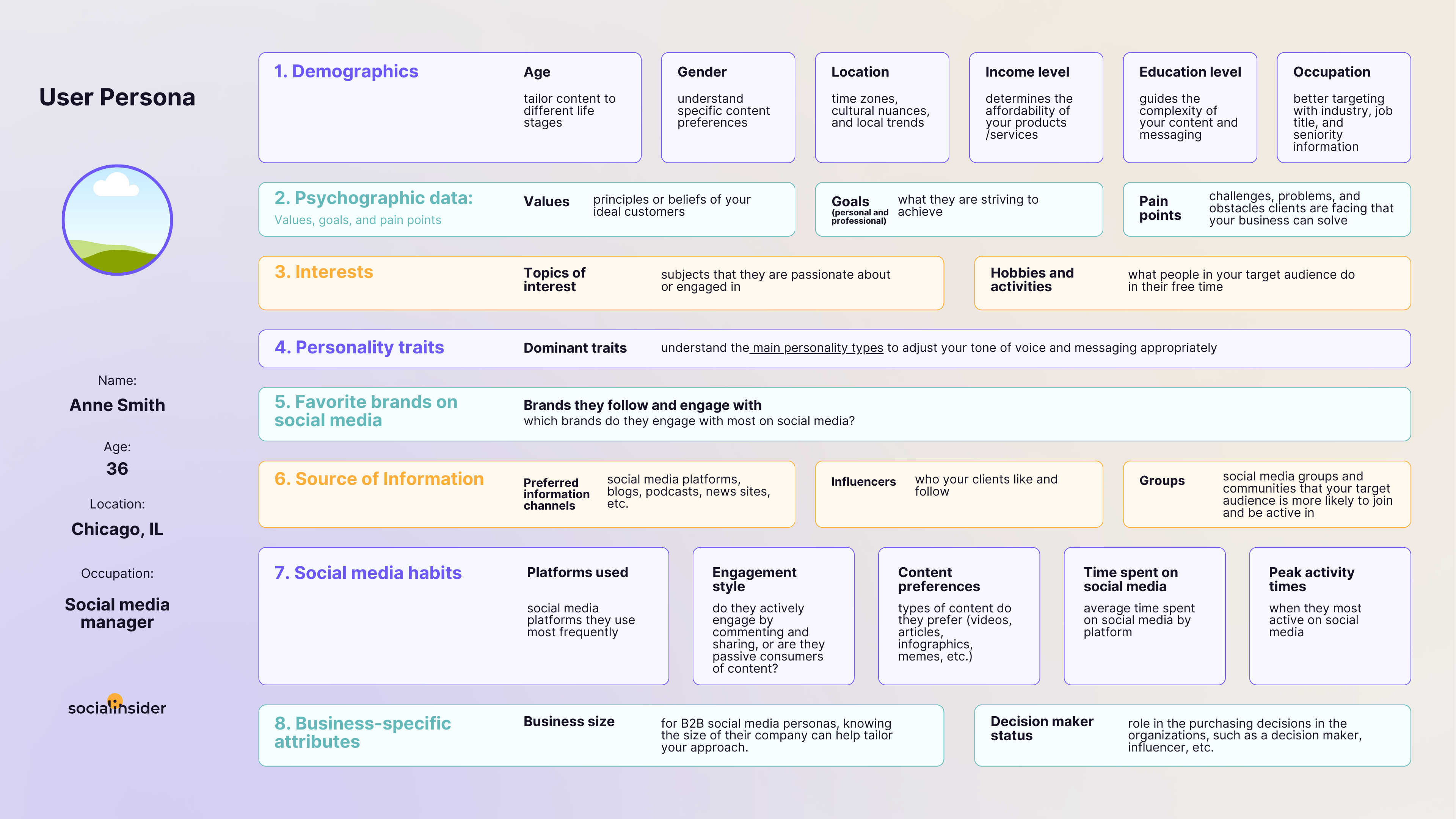
Strategy description (macro-level overview)
This section provides an overview of the proposed strategy, ensuring it aligns with the client’s goals. Instead of listing tactics, present a broader strategic vision, such as:
- Increasing brand visibility through influencer collaborations
- Enhancing engagement with interactive content
- Driving conversions with retargeting campaigns
The proposal should outline platform-specific strategies, balancing organic and paid social media content to maximize social media reach and ensure alignment with audience preferences and business objectives.
The strategy will define recommended platforms like Facebook, Instagram, LinkedIn, and TikTok, with content themes tailored for each.
For example, here's a sneak peek of how Booking.com divides its content pillars and balances content across TikTok and Instagram.
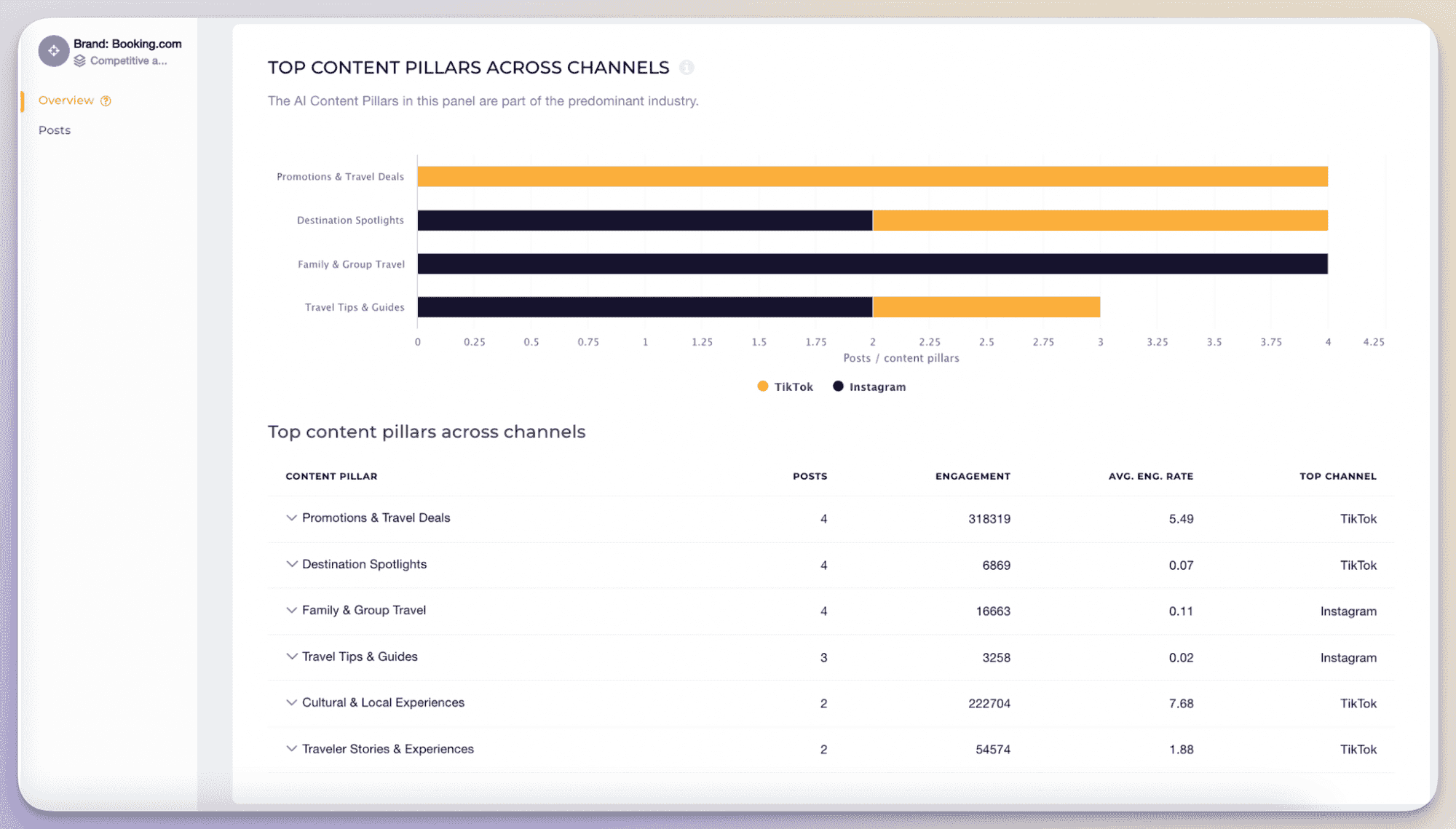
Socialinsider can be used as the go-to tool for tracking content pillars across channels to ensure the strategy is data-driven. It provides insights into high-performing social media content, audience engagement trends, and competitor benchmarks.
Using these insights, the proposal can help refine content strategies, optimize engagement tactics, and improve overall social media ROI through data-backed decisions.
This phase will also describe how different engagement initiatives, such as AR filters, contests, and interactive challenges, will be incorporated to boost audience interaction.
A structured timeline will map out campaign launch dates and budgets, ensuring a clear execution plan.
Content planning will also include a suggested posting frequency and distribution schedule to maintain audience consistency while driving measurable engagement.
KPIs analysis & results evaluation
Tracking the right KPIs is essential for measuring the success of a social media campaign. Therefore, the proposal should cover what performance data will be covered to evaluate the success of the social strategy proposed.
Depending on the focus of the plan, different metrics will hold varying levels of importance.
The most relevant KPIs should be aligned with platform-specific goals and divided according to the marketing funnel.
Top of the funnel (awareness & reach)
- Follower Growth – Tracks the increase in followers over time, reflecting brand awareness and audience expansion.
- Engagement Rate – Measures interaction level (likes, comments, shares) on posts, indicating how actively the audience is engaging with the content.
- Reach & Impressions – Measures how many users see the content and how often it appears in their feeds, helping assess brand visibility and content effectiveness.
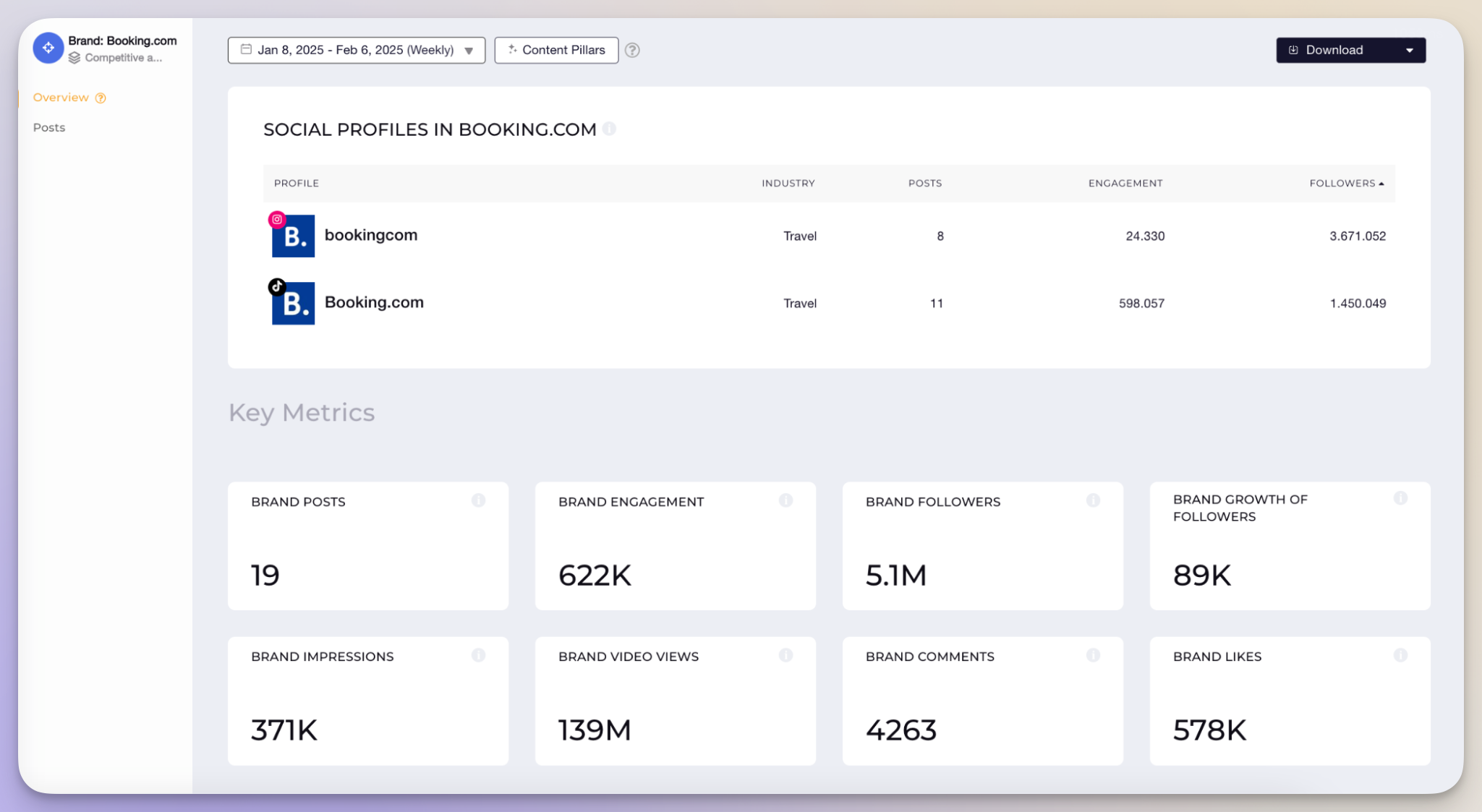
Middle of the funnel (consideration & actions)
- Click-Through Rate (CTR) – The percentage of users who click on a link after seeing a post or ad. This metric indicates how compelling the content is and whether it encourages users to take action.
Bottom of the funnel (conversions & revenue)
- Sales – Tracks direct purchases, lead form submissions, or other conversion actions attributed to social media efforts.
- Return on investment (ROI) – Compares the revenue generated from social media campaigns against the total cost spent, providing a clear measure of profitability.
By continuously evaluating these KPIs, social media strategies can be refined to improve performance, optimize budget allocation, and maximize overall business impact.
Case studies & testimonials
Including social media case studies and client testimonials helps establish credibility and demonstrate past success. This section should showcase how previous clients benefited from the proposed strategies and what measurable results were achieved.
What to include in case studies:
- Client background: Briefly introduce the business, industry, and challenges they faced before implementing the strategy.
- Strategy implemented: Outline the approach taken, key tactics used, and platforms leveraged.
- Results achieved: Present quantifiable metrics (e.g., increased engagement by 50%, generated $10,000 in sales, or improved follower growth by 30%).
- Client testimonial: A direct quote from the client validating the impact of the strategy.
Contract & Terms of Service (TOS)
To ensure transparency and prevent misunderstandings, the contract and terms of service section should outline the agreement's legal and operational details. This section should include:
- Scope of work: A clear breakdown of services offered, including content creation, ad management, engagement strategies, and reporting.
- Payment terms: Details on pricing, invoicing schedules, late payment policies, and refund clauses.
- Confidentiality & ownership: Specify who owns the content created and how confidential client data will be handled.
- Performance expectations: Define responsibilities, expected timelines, and deliverables.
- Termination clause: Conditions under which either party can end the agreement and any applicable penalties or notice periods.
Next steps
To streamline the onboarding process, provide clear action steps for the client to proceed.
- Sign the contract: Offer a link or document for electronic signature.
- Schedule a kickoff meeting: Provide a link to book a call or meeting for further discussions.
- Initial deliverables & timeline confirmation: Outline the first steps after contract approval, such as account audits, content calendar creation, or ad setup.
A strong closing section reinforces urgency, ensuring the client knows exactly how to move forward with confidence.
How to write a social media proposal?
Crafting a compelling marketing proposal requires research, strategic planning, and a results-driven approach. This step-by-step guide will help you create an effective proposal that secures client approval and sets the foundation for a successful collaboration.
Step 1: Research & understand the client’s needs
Before drafting the proposal, gather essential insights to tailor your strategy to the client’s specific needs. Consider the following:
- Industry and target audience: Understand their market position and ideal customer demographics.
- Current social media presence: Analyze existing platforms, engagement levels, and performance trends.
- Competitor analysis: Benchmark the client’s performance against competitors and identify gaps or opportunities.
- Market trends: Stay updated on relevant social media trends that could influence the client’s strategy.
Step 2: Write a strong cover page
The cover page should be visually appealing and include essential details:
- Proposal title (e.g., “Social Media Growth Strategy for [Client Name]”)
- Company name & logo
- Date of submission
- Client’s name & contact details
- Your contact information
Step 3: Craft an engaging executive summary
The executive summary should highlight the client’s key pain points and explain how your strategy will improve their social media presence. It should be concise, engaging, and persuasive.
Example:
“With a strategic approach to TikTok and influencer marketing, our team will help [Client Name] increase brand visibility and drive meaningful engagement.”
Step 4: Use a performance analysis as the change justification
Provide a performance analysis to support the need for a new or improved strategy. This should include:
- Strengths & weaknesses: Identify what’s working and where there’s room for improvement.
- Key performance metrics: Evaluate social media engagement, follower growth, and reach.
- Competitor comparison: Highlight how competitors are performing in comparison.
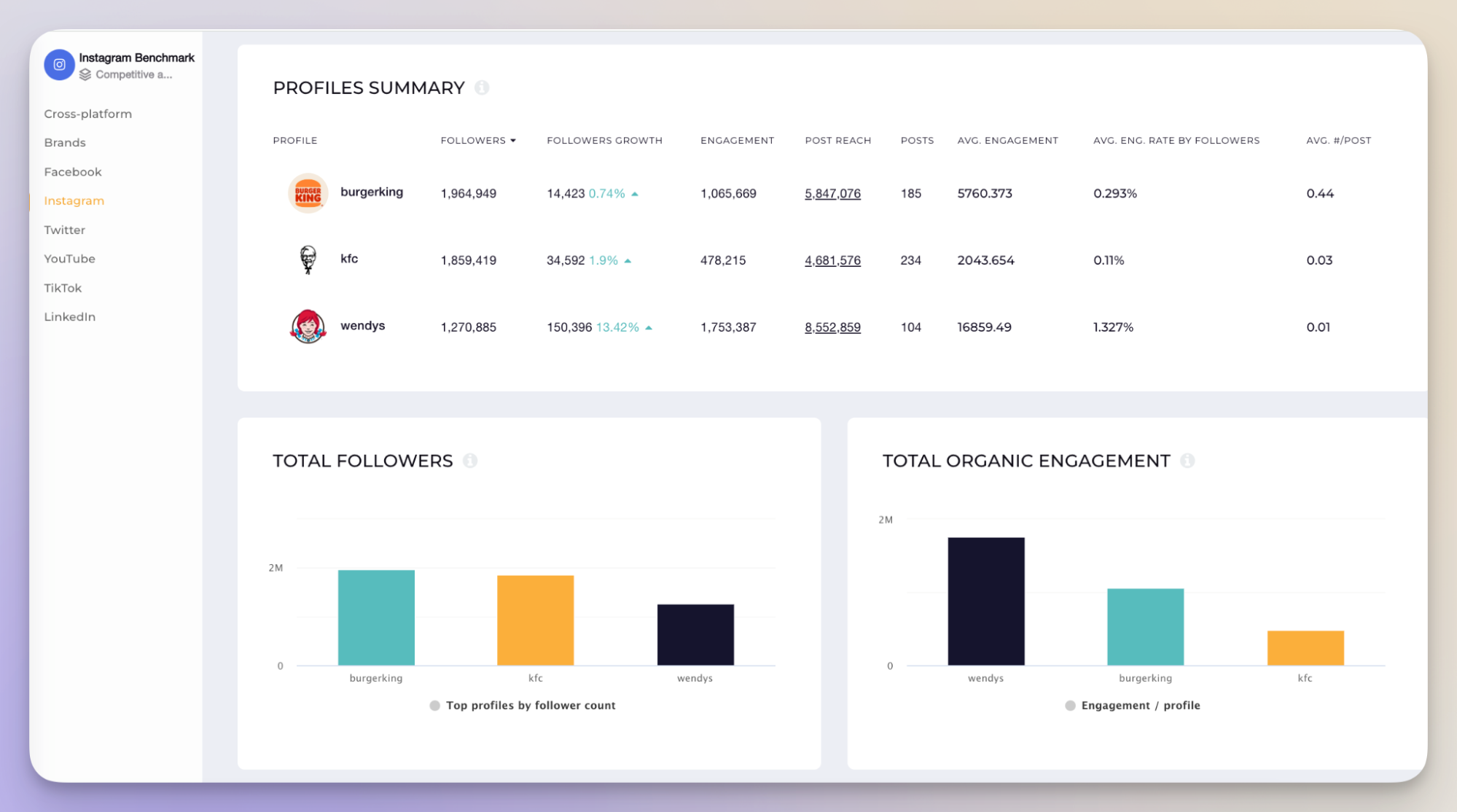
Example: In terms of engagement rate, both Burger King and KFC have values below the platform’s average, while Wendy’s boasts an engagement rate more than double the industry benchmark. This suggests that Burger King and KFC could improve their performance by replicating more of Wendy’s Instagram strategies.
Step 5: State the goals & objectives
Clearly define the social media goals, ensuring they are SMART (Specific, Measurable, Achievable, Relevant, Time-bound).
Example goals:
- Increase Instagram engagement by 50% in 6 months.
- Reach 20% more people through organic and paid strategies within 6 months.
- Improve brand awareness by 30 percent (which can be measured through follower growth) through influencer collaborations in the first month.
Step 6: Present your social media plan
Platforms usage
- Define which platforms will be used and why (e.g., Instagram for engagement, LinkedIn for thought leadership, TikTok for virality).
Content strategy & pillars
- Establish key content pillars (e.g., educational, promotional, community-driven).
- Define content formats (videos, carousels, reels, live sessions, etc.).
Social media campaign proposals
Each campaign should have a clear timeline, budget, and set KPIs.
Example:
- Valentine’s Day Campaign (Mid-Jan – Mid-Feb) – Targeted at increasing seasonal sales through UGC contests and influencer collaborations.
Content planning & posting frequency
- Define how often content will be posted on each platform (e.g., Instagram: 5 posts/week, LinkedIn: 3 posts/week).
- Detail planned content types (e.g., giveaways, interactive Q&As, influencer partnerships).
Step 7: Measurement & evaluation
To ensure the strategy’s effectiveness, outline how performance will be tracked.
Micro-level analysis (campaign-specific evaluation)
- Evaluate individual campaigns (e.g., Valentine’s Day campaign impact on sales and engagement).
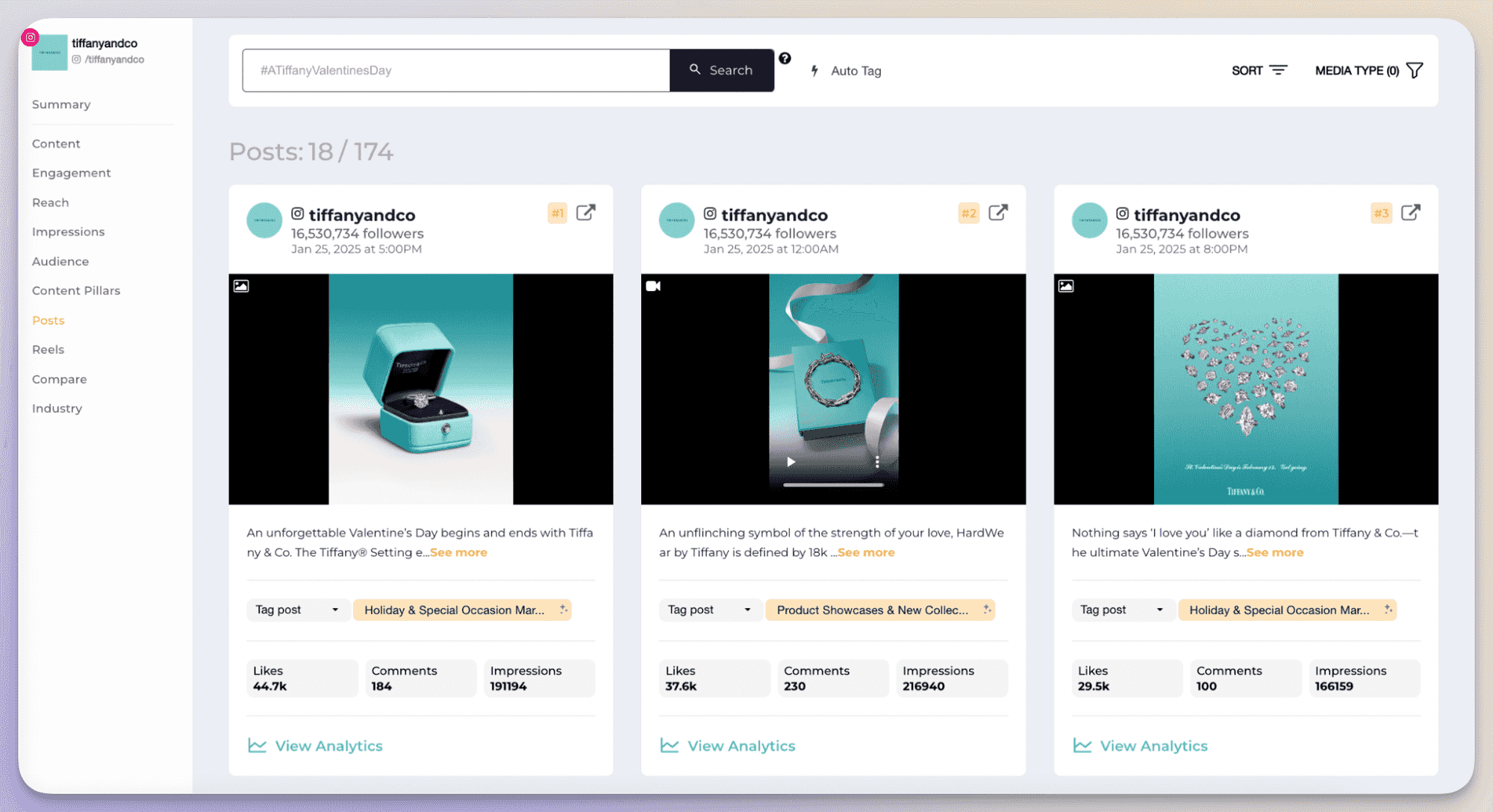
Macro-level analysis (overall strategy assessment)
Conduct quarterly evaluations to measure long-term progress.
KPIs should be continuously monitored, with adjustments made based on data insights.
Step 8: Provide testimonials
Showcasing past success builds trust and credibility.
Include:
- Client testimonials: Quotes from satisfied customers.
- Before-and-after metrics: Demonstrate impact (e.g., “Increased engagement by 50% in 3 months”).
- Screenshots of results: Data visualizations of engagement, reach, or conversions.
Step 9: Provide next steps
Make it easy for the client to move forward by clearly outlining the next steps.
Call-to-Action (CTA):
- Sign the contract: Provide a digital contract for approval.
- Schedule a kickoff meeting: Share a booking link.
- Confirm initial deliverables & timeline: Outline when the first set of actions will take place.
By presenting a structured and compelling social media proposal, you increase the likelihood of securing a successful partnership and delivering tangible results.
BONUS: Social media proposal template
To help you simplify the creation of your social media proposal, we've put together a template and an example with all the steps required.
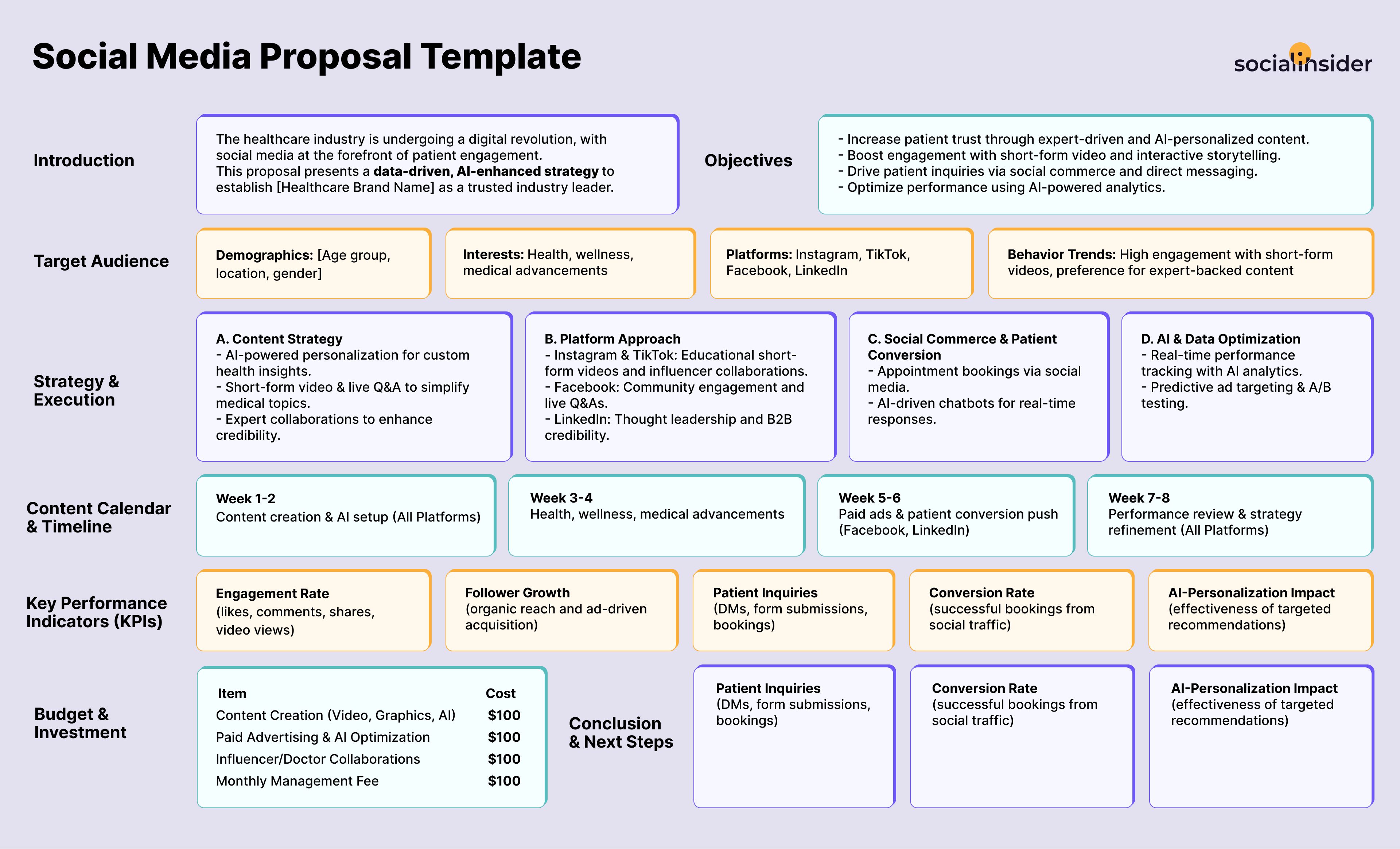
Final thoughts
Tailoring your proposal to the client’s specific needs, clearly outlining objectives, and showcasing past successes, can help you establish trust and increase the likelihood of winning the project.
The key to a successful proposal for social media marketing lies in thorough research, strategic planning, and data-backed recommendations. Ensure your approach is results-driven, integrates organic and paid strategies, and aligns with the client’s goals.
With a compelling proposal, you’re not just offering social media services—you’re presenting a solution that drives engagement, builds brand loyalty, and delivers measurable business impact. Now, use this guide to craft proposals that stand out and convert prospects into long-term clients.
Analyze your competitors in seconds
Track & analyze your competitors and get top social media metrics and more!
You might also like
Improve your social media strategy with Socialinsider!
Use in-depth data to measure your social accounts’ performance, analyze competitors, and gain insights to improve your strategy.




